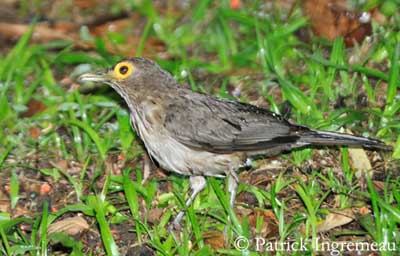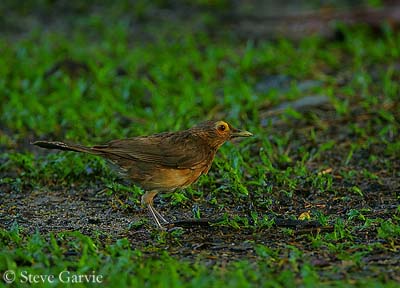
Yellow-eyed (Bare-eyed)Thrush
Turdus nudigenis
Passeriforme Order – Turdidae Family
BIOMETRICS:
L: 23-24 cm
Poids: 50-75 gr
DESCRIPTION:
Yellow-eyed Thrush is also called Bare-eyed Thrush, Spectacled Thrush, and it is also known as the “Big Eye Grieve”. All these names come from the broad, bare, yellow eye–ring.
Adult male has dull olive-brown upperparts, including wings and tail.
Underparts are paler. Chin and throat are white streaked with brown. Breast and neck sides are whitish to greyish-buff. Flanks are similar in colour but darker. Belly, vent and undertail coverts are white. Undertail feathers are brown.
On the under wings, coverts are similar to flanks, with variable coloration in coverts’ tips, from whitish, to orange and creamy-white.
On the brown head, bill is yellow with black top at base of upper mandible. Eyes are reddish-brown, with conspicuous bare, yellow eye-ring. Legs and feet are greyish-brown.
Both sexes are similar, and both are greyer in worn plumage.
DIET:
Yellow-eyed Thrush feeds mainly on fruit and berries. It also takes several kinds of invertebrates such as caterpillars, beetles, moths and earthworms.
PROTECTION / THREATS / STATUS:
Yellow-eyed Thrush populations are not globally threatened. This species is common to uncommon according to the range.
It is preyed upon by raptors.
Fr: Merle à lunettes
All : Nacktaugendrossel
Esp : Tordo Ojos de Candil
Ital : Tordo occhinudi americano
Nd : Naaktooglijster
Photographs by Patrick Ingremeau
Hisweb site:
TAMANDUA
Photographs by Steve Garvie
His website : RAINBIRDER Photo galleries
Text by Nicole Bouglouan
Sources:
HANDBOOK OF THE BIRDS OF THE WORLD Vol 10 by Josep del Hoyo-Andrew Elliott-David Christie - Lynx Edicions - ISBN: 8487334725
A GUIDE TO THE BIRDS OF COLOMBIA by Steven L. Hilty and William L. Brown - Princeton University Press – ISBN 069108372X
THRUSHES by Peter Clement and Ren Hathway – HELM - ISBN: 0713639407
Wikipedia (Wikipedia, The Free Encyclopedia)

Juvenile resembles adults, but it has narrower eye-ring. On the wings, we can see two orange-spotted wing bars. Underparts are pale buff with dark brown mottling on breast. Belly and vent are whitish. On head and mantle, plumage is dull brown with pale buff streaks.
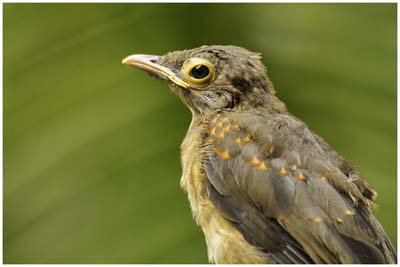
RANGE:
Yellow-eyed Thrush is resident in the Lesser Antilles, and in northern parts of South America, in Colombia and Venezuela, and northern Brazil. Also in Trinidad and Tobago.
BEHAVIOUR:
Yellow-eyed Thrush is mainly arboreal, mostly at low-level in trees, but it also forages on the ground, moving by walking, hopping and running when searching for food. This species consumes fruit and berries, and also several invertebrates.
It is often seen foraging in flowering and fruiting trees. It is usually alone or in pairs, but these birds may gather at abundant food resources, such as fruit.
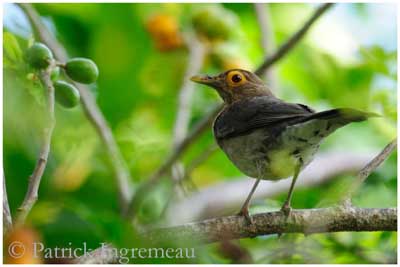
Yellow-eyed Thrush is shy, but in some parts of the range, it is observed at feeders. It may become aggressive when it defends food or territories.
Territorial defence and threat displays include several postures, in order to intimidate the intruder. The bird may fluff its plumage and raise the tail in vertical position. If it is really threatened, it tries to blend completely with the leaf-litter, or to make a low fast flight for cover, in order to hide.
This species is resident and breeds in its range. It is sedentary.
FLIGHT: No information
REPRODUCTION:
Breeding season occurs at different moments of the year, according to the locality.
Yellow-eyed Thrush nests at low-level in trees, in a fork between 2 and 8 metres above the ground, or in shrub, and even on the ground.
The nest may occasionally be reused for a second brood.
The nest is usually a bulky cup made with grasses, several plants materials and mud. Interior is lined with rootlets, and often with mud, as other Turdidae.
Female collects mud near water, and uses it as reinforcing material. This mud plays the role of insulating from weather conditions such as temperatures and rains.
Female usually lays 3 to 4 blue to pale blue-green eggs, with varied markings.
This species produces one or two broods per season.
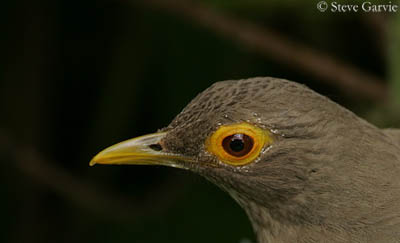
We can find two subspecies:
Turdus nudigenis extimus, from Northern Brazil;
Turdus nudigenis nudigenis, from the other parts of the range.
VOICE: SOUNDS BY XENO-CANTO
Yellow-eyed Thrush utters a melodious song, a series of sweet, fluted phrases and ringing trills with frequent pauses. It sings from high exposed perch all the year, but more from April to August.
Call is a cat-like “meow”, or a more musical “chareera”, also a harsh “tak-tak-tak”. Contact call is a monosyllabic frog-like note.
HABITAT:
ellow-eyed Thrush lives in semi-open and dry scrubby areas with scattered groves of trees, gallery forest borders, woodlands, parks and gardens. Usually seen below 1000 metres of elevation, it can be seen up to 1600 to 1800 metres in Colombia.
